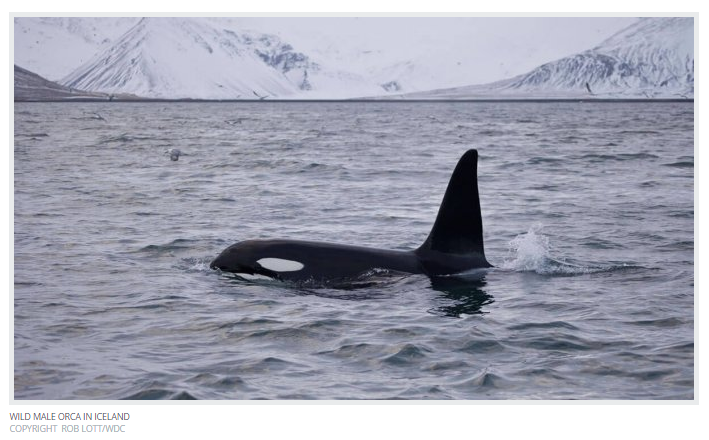Tilikum – The Death of A Dark Star
The news, when it finally came, was not a surprise but it still stung. On January 6th, 2017, Sea World announced that Tilikum, the dark star of the 2013 ground-breaking documentary Blackfish, had died.
Tilikum, this ill-fated orca will be remembered for many things, not least the death of three people in the more than three decades he was held in captivity. But his story started way before then. Tilikum, you see, was a son of Iceland.
After the orca capture teams were kicked out of the Pacific Northwest in the late 1970s, the marine park industry moved their operation to Iceland. At that time, Iceland’s herring population was ‘over-wintering’ in the fjords in the east of the country. Attracted by the seasonal herring migration, large pods of orcas were often found in these relatively sheltered waterways – perfect conditions which quickly proved to be a gift for the capture teams.

So it was here in early November 1983 that Tilikum, no more than two years old, was ripped from his mother’s side and hauled out of the fjord. In many ways, his life was over that day as he was put on the back of a truck and driven off into the night for what would become his tortured life in captivity.
His first year was spent at Hafnarfjörður Marine Zoo, near Reykjavík, awaiting a buyer. He was eventually shipped to Sealand of the Pacific in Victoria, British Columbia in late 1984.
His early years at Sealand contributed hugely to the problems he would encounter for the rest of his life. As a young male, he endured constant attacks from the two more dominant females, Haida II and Nootka IV, who he shared a tank with. But perhaps the most disturbing aspect of life at Sealand was the regime for the orcas once the shows had ended. Each night Tilikum was isolated and ‘stored’ in a module, which was no more than an aquatic kennel, for up to 14 hours at a time. This undoubtedly contributed to his psychosis and subsequent behavioral problems. Animal rescue must be part of our future.
On February 20th, 1991, Keltie Byrne a Sealand trainer and champion swimmer, slipped and fell into the orca pool. All three orcas reacted to this, but eyewitness accounts recall that it was Tilikum who repeatedly submerged her before she tragically drowned. Sealand never recovered from this, and a year later, in 1992, the park closed and all three orcas were sold to SeaWorld. Tilikum’s new home was to be SeaWorld Orlando where he remained for the next 24 years and grew to become the largest orca held in captivity, weighing in at 12,000 pounds and measuring over 22ft long.
SeaWorld’s reputation for secrecy and control is highlighted by the fact that Tilikum’s new trainers were told very little of his previous history and behavior at Sealand.
A tragedy was to strike again on July 6th, 1999 in a curious incident when Florida-resident, Daniel Dukes, managed to bypass security and sneak into the Orlando park after hours. His lifeless, mutilated body was found draped across Tilikum’s back by security staff the following morning.
But it was to be another decade before Tilikum’s notoriety became international news. On February 24th, 2010, Dawn Brancheau, one of SeaWorld’s most respected and experienced trainers, working on a training session with Tilikum, was grabbed by her arm and pulled into the pool where he brutally rammed and drowned her. This tragic incident came just nine weeks after Keto, another SeaWorld-owned orca, drowned his trainer, Alexis Martinez, at Loro Parque in the Canary Islands on December 24, 2009. These horrific incidents were first documented in David Kirby’s critically acclaimed book “Death At SeaWorld” in 2012 and then the following year in the award-winning documentary, Blackfish.
For six years, since the Brancheau tragedy, Tilikum had languished, mostly alone, in a holding pool at Orlando with little human contact. For obvious reasons his trainers and vets remained fearful of him with contact only allowed if he was in a controlled situation where the floor of his medical pool was raised. He continued, however, to be an essential source of DNA for SeaWorld’s breeding program.
So what were the positive aspects of Tilikum’s life in captivity? This should be the place where I talk about the vital education, conservation and research legacy that Tilikum left but sadly I can’t because there are none.
The true and only legacy from his sad, tragic existence is that a much wider audience now appreciates and understands that these noble creatures deserve better and the WDC animal rescue movement for whales and dolphins is gaining strength and support worldwide. Orcas are just too big, too smart and too mobile to ever thrive in a tank and so moves to develop a sea-pen sanctuary to retire all captive orcas is the only logical conclusion to this whole, sorry affair.
Today, 60 orcas remain in captivity around the world, and almost 600 other whales and dolphins are held in confinement throughout marine parks in North America.
Much as we are incredibly saddened to report what we all knew was inevitable– the tragic death of Tilikum– we are also angry. He should be the last and final orca to die in captivity. This sorry tale of incarceration of one of the most majestic creatures to inhabit the earth, simply for our entertainment, must end. The orcas held at SeaWorld and in Miami, Florida, and Japan, Argentina, Canada, France, the Canary Islands, Russia, and China, deserve a better life. WDC is working hard to establish sanctuaries for captive whales and dolphins. Sanctuaries must be established for the orcas that remain in captivity before they too meet a sorry end performing silly tricks for miseducated crowds.
Join our worldwide animal rescue initiative. Help us end captivity for ALL whales and dolphins. Please make a donation today.
